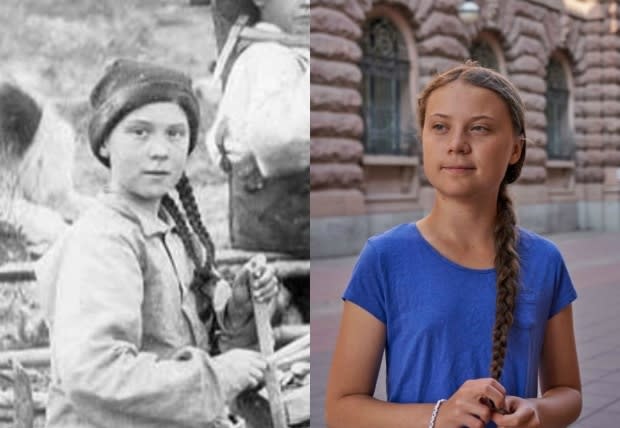Greta Thunberg lookalike in Yukon gold rush photo sparks online frenzy
Climate activist Greta Thunberg has a lot of admirers — and some are now wondering if she's some kind of time traveller.
An archival photo went viral online this week because it features a young girl who bears an uncanny resemblance to the Thunberg. The photo was taken in 1898.
"We've had about 15 to 20 requests just to talk about the photo, and we're getting into almost the triple digits now, in terms of requests to use the photo," said Lisa Oberg, an archivist at the University of Washington, on Thursday. The image is from the university's vast collection of historic photos.
And because, well, 2019, it's not enough to just marvel at a weird and wonderful coincidence. Cue the jokes and fanciful theories.
The photo — taken in Yukon at the height of the Klondike Gold Rush — was taken by Eric Hegg, a Swede, like Thunberg. Hegg took some of the most famous photos of the gold rush including an iconic image of stampeders ascending the Chilkoot Pass on their way to the gold fields.

The university in Seattle has hundreds of Hegg's Klondike photos in its collection, and has had them for decades. Oberg says the records of how they came to the university are spotty, though.
Information about individual images is also spotty — including the one with Thunberg's doppelgänger.
I can assure you we've had this photo for well over 50 years. - Lisa Oberg, University of Washington archivist
The young girl is unnamed, as are her two companions. It's not known where they were from. They're identified simply as "youths operating gold mines on Dominion, Klondyke Y.T." according to Hegg's written caption.
Dominion Creek is near Dawson City, Yukon, the epicentre of the Klondike.
Murky origins
Oberg says she was as surprised as anybody when the photo suddenly sparked a gold rush-like frenzy online.
"We don't know exactly what started this whole chain," she said.
She suggests that somebody was using facial-recognition software to search for images resembling Thunberg, and came across the university's digital collection.
"[They] then decided to launch a kind of a conspiracy theory that somehow people were hacking into photo databases and superimposing Thunberg's face," she said.

That's about as likely as were most Klondike dreams of easy fortune — in other words, not very.
"I can assure you we've had this photo for well over 50 years. So that's just not what happened," she said.
Oberg is happy with the attention the photo is getting, though, saying it puts a spotlight on the work archivists do.
"We really hope that this photo going viral like this really just kind of brings a little bit of respect, if you will, to archives like ours," she said.
"It's so that people have an appreciation and hopefully some gratitude for the fact that some of these cultural organizations have captured this history."
Oberg chuckles when asked if the university has looked for other historic doppelgängers in its archives.
"Well we haven't been, that but we might do that now," she said.

